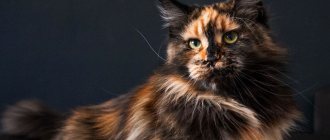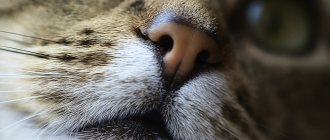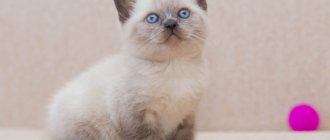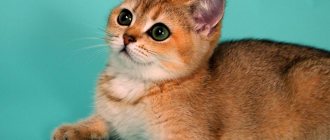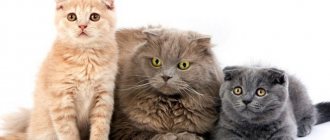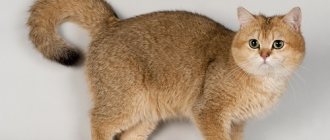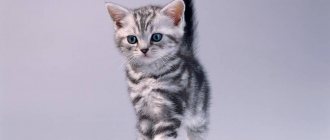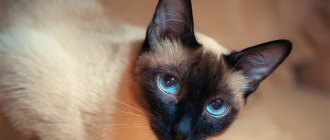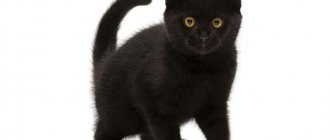The Abyssinian breed first appeared in 2001, but this species has only become popular in our time. The differences in the appearance of Abyssinian cats are quite minor. For example, some breeds have ticking (when the coat is covered with a smooth transition from one shade to another), while others do not have any patterns on their coat at all.
If you look closely at these pets, each fiber is painted in two colors, which alternate with each other.
It is precisely because of its fur that the Abyssinian cat differs from other breeds; they have it:
- shiny;
- smooth;
- short;
- without drawings;
- ticking.
These kittens have an undercoat that is very bright and rich. The only thing that an Abyssinian can have on its body is a white chin (see all photos of the Abyssinian cat).
Experts have officially recognized only four types of color of these kittens - these are:
- faun;
- sorel (red);
- blue;
- wild.
So let's discuss all these colors together.
Breed standards
The main set of features consistent with the standard is given in the table.
Table 1. Abyssinian breed standards
| Part of the body | Standard |
| Head | The shape resembles a blade that turns into a graceful and elongated neck |
| Ears | Wide and deep, have ends of a darker shade. Sometimes there are tassels |
| Eyes | Almond-shaped, distinguished by dark rims that surround “glasses” of a more delicate color |
| Chin | Neat and not beveled. An exception is made for adult cats with a protruding chin. |
| Frame | Flexible and flexible, with well-developed musculature |
| Paws | Oval and compact. Five toes on the front paws and four on the hind paws |
| Tail | Tapering towards the end and thickening towards the base |
Over the last century, the Abyssinian cat has decreased in size, maintaining all proportions
Possible deviations
Abyssinian cats may have deviations from generally accepted standards, which are called faults. A list of these deviations is given below.
Table 2. Deviations from the Abyssinian breed standards
| Localization | Deviation |
| Forelegs | Availability of stripes |
| Neck | The necklace around the neck is torn in one or more places |
| Undercoat | Too light shade; does not have enough gray color |
| Eyelids | There is no characteristic edging |
| Body | Too few ticking stripes; presence of ghost ticking pattern |
What colors do Abyssinian cats have?
Today, Abyssinian cats are considered one of the most expensive breeds. To some extent, this is due to a beautiful “fur coat” with a beautiful color. The most common animals in the world with this coat color are:
- classic wild;
- sorrel;
- blue;
- faun;
- brown;
- lilac;
- tortoiseshell;
- silver.
Among all other colors, wild is the most popular
Thanks to uniform ticking throughout, these cats have a kind of “calling card” - each hair along its entire length is colored in different (light and dark) shades.
Classic wild color
The wild classic color is the fundamental color of the “fur coat” of representatives of this breed.
Interesting! Until 1963, this color was the only one that the relevant organizations approved as the standard for Abyssinian cats.
For a long time, only the wild color of the Abyssinians was recognized
The classic wild color is characterized by the following features:
- Presence of uniform ticking throughout all parts of the body.
- The body is distinguished by a more saturated orange-brown color.
- On the inside of the paws, as well as on the tummy, the fur is colored buffy.
- There is black feathering on both the front and hind legs. In many animals it even transfers to the pads.
- Along the entire ridge line there is a fairly wide black stripe, which smoothly ends at the very tip of the tail;
- The brick-colored nose is outlined along the edges with a darker edging.
- Abyssinians can have eyes of different colors: green, hazel or golden. However, it is worth noting that all kittens are light blue until about ten months of age.
Wild color is also the most commercial
Today, wild color is the most common among Abyssinian cats. In addition, many cats have this coloring at the genetic level.
Sorrel color
The color sorrel (red) is a lightened tone of the classic color. This shade was officially recognized for the Abyssinian breed in 1963, but until the late 70s it was most often called red.
The sorrel color involves a smooth transition of several warm shades into each other.
Animals that have this color attract attention because the color of their coat is a mixture of several rich shades: reddish, copper, bright apricot, and chocolate brown.
The characteristic features of sorrel include the following:
- Most pets have coats that are bright copper in color.
- There are two types of ticking: both dark chocolate and cinnamon shade.
- The inner side of the limbs and the abdominal area are covered with the lightest hair.
- A red-brown stripe runs along the spine, which is much darker than the dominant shade of the coat. The color of the tail is rich brown.
- There are beige-pink pads on the paws, and light chocolate flesh is visible between them.
- The nose has a pink tint. It is edged with a dark red rim.
- The most common eye colors among representatives of the breed are copper and gold. However, some Sorrel-colored pets have greenish or light brown eyes.
Sorrel is the calling card of the Abyssinian, not found in other breeds
Interesting! Sorrel-colored wool is very rarely found in representatives of other breeds. At the same time, according to standards, the Abyssinian coat should not contain black hairs.
Blue color
Organizations have officially approved the blue color for Abyssinian cats. Such animals differ from others by having a “fur coat” of a delicate and very impressive color.
The following standards are established for these animals:
- On the head, back, and head there is a characteristic pattern resembling a tailcoat, which has a beautiful bluish-gray color.
- On the chin, the inside of the limbs, in the abdomen and chest, the color of the coat is lighter - fawn, beige, pale brown, cream or apricot.
- The undercoat is a lighter shade than the main color.
- Ticking is present throughout the body and has the characteristic shade of an overcast sky.
- A fairly thin stripe runs along the entire spine, which stands out against the background of the ticking in a brighter blue color.
- The nose of these animals is either brown or gray-blue, but always has a dark edging.
- Pale pink paw pads are covered with sparse bluish hair.
- Eyes with a blue color are often golden and copper, but cats with green and hazel are often found. At the same time, many people pay attention to their special expressiveness and unique beauty.
The blue color received the green light from the exhibition managers not so long ago
Important! According to the standard, Abyssinian cats with blue fur should not have bleached undercoat.
Fawn color
The unique color fawn (translated as “fawn”) was approved in 1989. Today, this color is considered the rarest and most modern coat color. In essence, it is a shade of sorrel, but lighter.
Fawn - the lightest and softest of all colors
Important! Faun is not as common as the above variants. However, it is highly valued by many breeders. Pets have such an exquisite “fur coat” that they resemble little lionesses, attracting attention with their special sophistication.
Characteristics:
- The fur on the body is a coffee or cocoa-with-milk color.
- A stripe with a darker beige-pink color runs along the spine.
- At the tip of the tail the fur is a rich pink-beige color.
- The guard bones, like the undercoat, are colored cream or pale sand.
- Throughout the body there is ticking of a combined color: cream with lilac-beige.
- In the tummy area and on the inner surface of all legs near the body, the fur has a specific oat color.
- Pink nose with reddish edging.
- The paw pads are covered with sparse beige-pink fur.
- Different eye colors: copper, golden, greenish, dark hazel.
To participate in exhibitions, Abyssinian fawn cats must not have a bleached undercoat.
Despite its prevalence, the faun is still awaiting recognition
It should be noted that representatives of this breed can have other colors: brown, tortoiseshell, lilac or silver. However, despite the fact that recently they are found quite often, they are not considered to be generally recognized coat colors.
Character and behavior
The Abyssinian cat has an exotic appearance and character, which is distinguished by the behavior of an animal with unique wild habits. In many ways, their character and behavior have both pros and cons.
Abyssinians have the following positive traits:
- despite their exotic and arrogant appearance, Abi cats are kind, affectionate animals;
- play well with small children and do not release their claws during communication, are patient with the pranks of children and are friendly with other animals in the house;
- they easily get used to the established rules in the house, they know from childhood what a tray and a scratching post are, and that they should not spoil furniture and carpets;
- intelligent, inquisitive animals and, with persistence, amenable to training;
- they are distinguished by their cleanliness and, due to their short coat, shed relatively little, only in spring and autumn;
- have good health in the absence of genetic abnormalities.
Relatively negative character traits of the Abyssinians can be considered:
- the incredible activity of the cat, it creates an abundance of noise in the house;
- they can be timid; loud noises can cause them to jump up sharply and scare members of the household;
- having played too much, they do not feel obstacles, they are capable of not only breaking something, but also injuring themselves, even to the point of breaking bones;
- often pets are located on the windowsill and can fall out of the window;
- Abi's pets cannot stand loneliness, they always suffer and, in retaliation, begin to mischief, creating trouble for the owners in the house;
- Abyssinian cats are talkative and can make shrill sounds from the very morning, which is especially annoying when they scream heartbreakingly during estrus.
Abyssinian cat video
What genes are responsible for the color and tone of the coat?
A particular coat color is determined by the level of melanin, as well as the coloring pigment present in the animal’s body. Experts distinguish two types of substances that provide the basic colors of cats:
- Eumelanin is responsible for the presence of black ticking.
- Pheomelanin is responsible for the red tint of fur.
Nowadays there is still a struggle for the recognition of new colors of the Abyssinian cat
The black series of colors includes several different shades. They depend on the following set of genes:
- B (black) is a dominant gene responsible for black color.
- b (brown) is a recessive gene relative to B, and a dominant gene relative to bl. The presence of a rich chocolate shade depends on it.
- bl (brown light) is a recessive gene that is present in the body of pets with the Sorrel color.
Thanks to the above genes, which belong to the so-called “black group,” active synthesis of eumelanin occurs. And the O gene is responsible for the red color of the coat, thanks to which pheomelanin is produced.
Abyssinian kittens are very fluffy, the breed can only be recognized by their color
According to research, the color of animals depends not only on color, but also on tone. The gene code contains a dominant gene D (dense), as well as a recessive gene d (diluted), which, in fact, give a rich light or dark color.
In addition to separation by color, there is a coming trend of demarcation between the European and American types of Abyssinian cats
Dominance, like recessivity, manifests itself in such a way that dominant DD genes or a dominant gene with a recessive Dd can be combined - these combinations give a dark shade. In addition, recessive dd genes are also combined, resulting in a lightened coat tone.
In the pedigree trees of Abyssinian cats (abbreviation ABY), the letters n, o, a and p are used to designate colors.
Table 3. Dependence of color on a set of genes
| Color | Designation | Genes |
Wild color | ABY n | BBDD, BBDd, BblDD, BblDd |
Sorrel | ABY o | blblDD, blblDd |
Blue color | ABY a | BBdd, Bbldd |
Faun | ABY p | blbldd |
Due to its compact size and uniform color, the Abyssinian cat was nicknamed “rabbit”
The color of the Abyssinian breed belongs to the tabby color group. The Agouti A gene is responsible for it, which determines the alternation of dark and light areas on all hairs.
Owner reviews
Brother and sister are as different as the sun and the moon. Eric is a big neat guy, he is hair to hair, Flora is always licking his fur in different directions. Eric is afraid of everything new and noisy, Flo runs headlong towards the commotion. Eric obeys and is afraid when I scold him, and gray hair is like water off a duck's back. But they are both very mobile and active, both sit on their hands a little, and are very smart.
irainmost
https://irecommend.ru/content/moi-khorek-enot-nu-tochno-ne-koshka-lyubimaya-flora-velikolepnyi-erik-i-vse-chto-v-nuzhno
This is the cat who greets you when you come home, who follows you everywhere, he shows interest in everything you do. He runs after his brother like a tail, starting with brushing his teeth in the morning and falling asleep on his lap in the evening. I have only seen this in dogs! But what won me over was the fact that he carries his toy mice. He brings the larger one to his bowl for “feeding”, and he bathes the smaller ones in his glass of water - throws them in and pulls them out with his paws.
demenoid
https://otzovik.com/review_150400.html
How to care for Abyssinian cats?
If you properly care for an Abyssinian, he can live for about twenty years. However, some animals exhibit genetic pathologies such as polycystic kidney disease, atrophic retinopathy of the eye, and blood diseases caused by the destruction of red blood cells. In addition, cats often suffer from gingivitis and leukemia.
Abyssinian cats can safely be called long-livers
To prevent the development of many diseases and all kinds of complications, the following rules must be followed:
- Maintaining a proper diet.
- Brush your teeth twice a month.
- Brush the coat once a week with a special brush to remove dead hair.
- Trim nails as needed.
- Get checked by a veterinarian.
- Get vaccinated.
Video - Characteristics of the breed and methods of care
What to feed Abyssinian cats?
To maintain the health of pets and a beautiful “fur coat,” it is important that they have a nutritious diet. It can be either natural or industrial.
Representatives of the breed will not refuse fruit either.
It is better to prepare a diet of natural products together with a veterinarian so that the cat receives all the vital vitamins and minerals along with food. To do this, the animal should be given the following products:
- Boiled meat (preferably lamb and beef) and poultry.
- Sea fish.
- Boiled vegetables in chopped form.
- Dairy products.
- Eggs.
- It is recommended to add a little flaxseed or olive oil to your food.
- Vitamin complexes.
Among dry food, give preference to the premium segment
Many owners of Abyssinian cats prefer industrial food. However, you should only use extra-premium dry and wet food, as well as holistic food, which is based only on natural ingredients. If there is intolerance to certain food ingredients, the Abyssinian cat may develop an allergy. Read more about its symptoms and treatment on our portal.
We will look in more detail below at the foods that under no circumstances should be given to an Abyssinian cat.
Dangerous foods for the Abyssinian cat
Health
Abyssinian cats are generally quite healthy. With proper care and good heredity, an animal can live 12–15, and sometimes 20 years.
However, they are susceptible to a number of diseases. Among the most common in the breed:
- pyruvate kinase deficiency;
- progressive retinal atrophy;
- kidney amyloidosis;
- gingivitis;
- depression.
Pyruvate kinase deficiency
Pyruvate kinase deficiency is a hereditary disease that automatically leads to anemia. Her symptoms:
- weakness;
- decreased appetite;
- weight loss;
- deterioration in wool quality;
- pallor and sometimes yellowness of the mucous membranes of the mouth.
Symptoms of anemia may disappear from time to time without outside intervention, then appear again. Exacerbation is provoked by pregnancy, infections, and certain medications. The disease also progresses in older animals.
A DNA test helps identify the problem.
Effective conservative treatment has not yet been developed. To maintain strength, your veterinarian may prescribe folic acid and red blood cell replacement therapy. Sometimes splenectomy is used, that is, removal of part of the spleen.
Progressive retinal atrophy
Progressive retinal atrophy is a hereditary disease that causes degeneration of the retina of the eye, gradually leading to blindness. Initially, it manifests itself as the animal's growing awkwardness due to deteriorating vision. As the disease progresses, the pupils dilate and light begins to reflect from the back of the eye. Sometimes the lens becomes cloudy.
For diagnosis, an ophthalmological examination and sometimes electroretinography are performed.
There is no cure. However, most cats quickly come to terms with blindness and navigate the apartment by smells and memory. Problems can arise for them only due to rearranging the furniture.
Renal amyloidosis
Amyloidosis is a metabolic disorder that causes pathogenic amyloid protein to accumulate in the kidneys and other organs. It is believed that the disease is hereditary or develops due to infections, inflammation or severe poisoning. Usually young animals or mature animals over seven years of age are affected. Abyssinians account for 97% of cases of this disease among cats.
The symptoms are:
- exhaustion;
- increased thirst;
- frequent urination;
- sometimes vomiting;
- digestive disorders;
- pallor of the mucous membranes.
Vascular thrombosis, abdominal dropsy, and swelling of the muzzle and extremities may develop.
Diagnosis includes blood and urine tests, sometimes x-rays and a kidney biopsy.
A complete cure is currently impossible, but if the disease is detected at an early stage, the right diet and symptomatic therapy can prolong the animal’s life for a long time.
Gingivitis
Gingivitis is inflammation of the gums. Without treatment, it spreads to the ligaments and bones of the jaw. The tooth begins to become loose and falls out after a while. In advanced cases, inflammation affects internal organs, including the liver and kidneys.
The disease develops due to tartar. Shows itself:
- severe salivation;
- bad breath;
- red, swollen and bleeding gums.
The diagnosis is made based on visual examination. In some cases, a biopsy is needed.
Treatment depends on the stage:
- in the early stages, you can get by with removing tartar and regular teeth cleaning;
- in the later stages, medicinal ointments, antibiotics, immunomodulators and anti-inflammatory drugs will be needed.
Regular tooth brushing is important to prevent gingivitis
Depression
Depression in Abyssinians occurs due to lack of attention. It is expressed by baldness in the area of the back and hips, and the cat can pull out its own hair. Constant skin irritation leads to ulcers and dermatitis.
In addition to symptomatic treatment, it is necessary to eliminate the cause of the disease: the animal should be given more attention, and if this is not possible, make a friend for it.
Genetics of Abyssinian cat colors
Genes responsible for coat color
In order to understand it thoroughly, let's start from afar. The coloring pigment, melanin, which provides a particular hair color, comes in two types: eumelanin (responsible for black color), and pheomelanin (responsible for red, more precisely red, color). Accordingly, there are two basic colors – black and red (red).
The black series colors have several shades. They are determined by the following gene family:
- B (black) – black color (dominant gene),
- b (brown) – chocolate, i.e. dark brown color (dominant in relation to bl, recessive in relation to B),
- bl (brown light) – cinnamon (sorrel), i.e. light brown (recessive gene).
These genes ensure the production of eumelanin, and the corresponding colors belong to the colors of the black group.
The O gene is responsible for the red (red) color, which promotes the production of pheomelanin.
It may seem that Abyssinian cats of wild and especially Sorrel colors are red. Don't believe your eyes! They are black! At least genetically.
The color of the Abyssinian cat is determined by the action of eumelanin, and not pheomelanin, the pigment of the red series. The light brown and yellow-sand zones on each hair hair are formed by the same eumelanin as the darker zones, i.e. These are all shades of black. The light brown or yellow color is due to a change in shape and a decrease in the distribution density of pigment granules.
For quite a long time there was an opinion that the Sorrel-colored Abyssinian cat is genetically a ginger (red) cat. It is not right! In appearance, these cats really look like red cats, but genetically they have nothing in common with the red gene O. The color of the stripes - yellow and light brown - on the hairs of such cats is formed due to the strong oxidation of the black pigment eumelanin. Sorrel is essentially a light brown (cinnamon) color, i.e. black series color.
Initially, the color of the sorrel was mistaken for red, apparently due to the fact that yellow, sandy color is associated with orange. However, the pigment responsible for this sandy color in Abyssinians is still the same eumelanin and in no case pheomelanin.
Genes responsible for color tone
The color of Abyssinian cats is formed not only due to the color itself, but also due to the tone of this color. The dominant gene D (dense) and its recessive “companion” d (diluted) give, respectively, “saturated”, i.e. dark and light colors. The blue color is a “lightened” wild, and the fawn is a “lightened” sorrel.
Dominance/recessiveness is manifested as follows: the combination of dominant DD genes or dominant and recessive Dd genes gives a dark color. The combination of two recessive dd genes will produce lightening.
The colors are the same: BB and B bl – black, bl bl – cinnamon.
In relation to Abyssinians: wild color is a combination of black color and rich tone. At the genetic level, it is a combination of a pair of BB (or Bbl) genes with a pair of DD (or Dd) genes. Blue color is a combination of black color and light tone, i.e. a combination of the same combinations of “color” genes with a pair of dd.
Similarly: the sorrel color is the color of cinnamon (sorrel) plus a rich tone, i.e. bl bl plus DD (or Dd). Fawn is a “lightened” sorrel, i.e. bl bl plus dd.
The colors are designated in pedigrees by the letters n, o, a, p, and the Abyssinian breed is designated by the abbreviation ABY.
| Color | Designation | Genes |
| wild | ABY n | BBDD, BBDd, BblDD, BblDd |
| sorrel | ABY o | blblDD, blblDd |
| blue | ABY a | BBdd, Bbldd |
| faun | ABY p |
Generally recognized colors
The peculiarity of Abyssinian cats is that they are not born with a “ready” color. The final color appears as the animal matures: kittens are darker than adults. The breed is also characterized by a multidimensional coat color: at the base, each hair is light, and closer to the tip it acquires a darker color. According to its tone, the hair can be divided into 3-4 zones.
The Cat Fanciers Association (the world's largest association for owners of breeding animals) allows only four colors of Abyssinians. These are “ruddy”, blue, “fawn” (“fawn”) and “sorrel”.
"Wild" (Ruddy)
The most common color of the breed. Ticked color, the owners of which are characterized by the following:
- The predominant shade is rich reddish brown.
- The base of each hair is light. The tip of the hairs is black. Each hair is ticked.
- Dark brown, almost black legs.
- The nose is brick (reddish-red) in color.
Ruddy colored cats:
Blue
The second most common color of Abyssinian cats. Blue is a conventional name: a cat’s fur can be visually identified as gray-beige with a silvery tint. It seems that the animal’s grayish coat is illuminated from the inside with a soft beige light.
This effect is achieved by ticked, multidimensional hair coloring. At the base they are light, beige or creamy pinkish. Towards the tip the hair darkens - gradually acquires a silver-blue and then a dark gray tone. An exception for multidimensional coloring is the “palms” and “heels” of the animal. They should be dark gray in color.
Blue cats:
"Faun" ("fawn")
From the name you can judge that this is a delicate fawn, beige cat with a dark cinnamon pattern. The “fawn” coloring is one of the rarest among representatives of the Abyssinian breed.
The hairs of such cats at the base are light fawn, light beige or pinkish-beige. Towards the tip they gradually darken to a warm dark brown tone, a cocoa shade. The skin on the nose and paw pads is pinkish or dark cream. The “fawn” color of the Abyssinian is valued for the pinkish glow of the cat’s coat.
Faun cats:
"Sorrel" ("bay", "sorrel")
This color is one of the most common among Abyssinians. Visually, the animal’s fur looks golden, richly copper. On top of this beautiful color is a chocolate coating.
The ticked fur at the base is yellowish-brown (this gives a “copper” or “gold” effect). Towards the tip of the hair the tone changes to a rich chocolate brown.
The back parts of the animal’s legs, “palms” and “heels” are plain, cocoa-colored. The nose is pinkish.
Sorrel cats:
What about eye color?
Abyssinian kittens are born blue-eyed, like most cats of other breeds, the main color is formed by three months of age. Some breeders believe that the longer the eye color fades, the brighter the final color will be.
Photos of Abyssinian kittens from the Abysphere nursery
All Abyssinian colors are characterized by yellow-orange eye color, which harmonizes perfectly with all four colors. The more expressive and brighter the eye color, the higher the cat will be rated. There is also a yellow-green eye color called hazel. But the rich green tint of the iris is very rare for Abyssinians.
Rare colors
Although the Association of Cat Fanciers recognizes only four colors of Abyssinians, representatives of the breed can have other colors that are no less beautiful and multi-dimensional.
Silver
Ancient chronicles indicate that “silver” is the earliest color of the Abyssinian cat. But since high-quality photographic equipment did not yet exist centuries ago, it is difficult to judge what the suit was. This is the main reason why the Association does not include it among the standard Abyssinian breeds.
Modern silver Abyssinians are characterized by a ticked coat with a transition from silver-gray to black. At the base the hair is practically unpigmented, gray with a shiny steel tint. It darkens to black towards the tip. The transition does not look contrasting - light gray, beige, dark cream and cinnamon ranges are visible on the hair.
The paws of silver cats are colored evenly, monochromatically – black. The color of the nose varies from dark pink to salty red depending on the richness of the color.
Often silver Abyssinians are born with defects - spots, stripes on the fur. Finding an animal of the perfect silver color is a rarity these days. The additional color is graded depending on the predominant colors in the ticking:
- "Blue Silver" The base is white and gray. The tip of the hair is blue-gray. This gives the effect of a silver-blue coating on the fur coat.
- "Fawn Silver". The base of the hair is silvery and white. The tip is dark beige, dark fawn. Spray tone – soft yellowish-gray, yellowish-blue.
- "Sorrel silver". The coat is silvery at the base, then turns into a cool chocolate color. The tone of the spray on the fur coat is peach with a silver tint.
Abyssinians "silver":
Chocolate
Despite its lack of recognition, it is one of the most common colors of Abyssinians. In such animals, the base of the hairs is copper and golden. Then - an apricot transition to a rich dark chocolate tone. All paws are a single cocoa color. The visual effect is a fur coat of a bright copper shade with chocolate coating.
Chocolate color:



